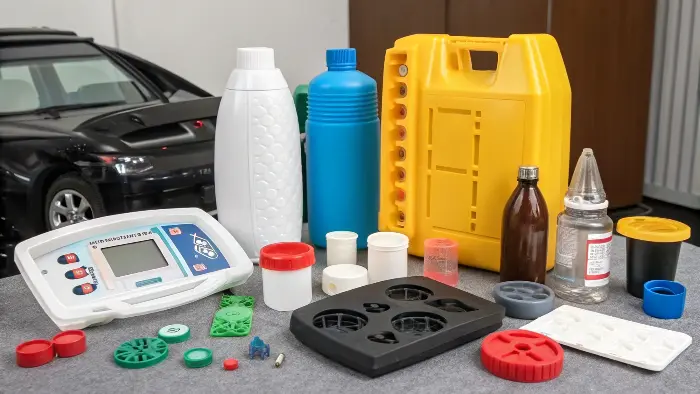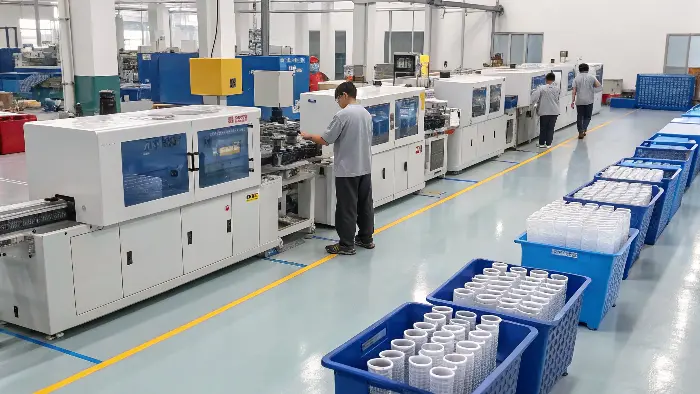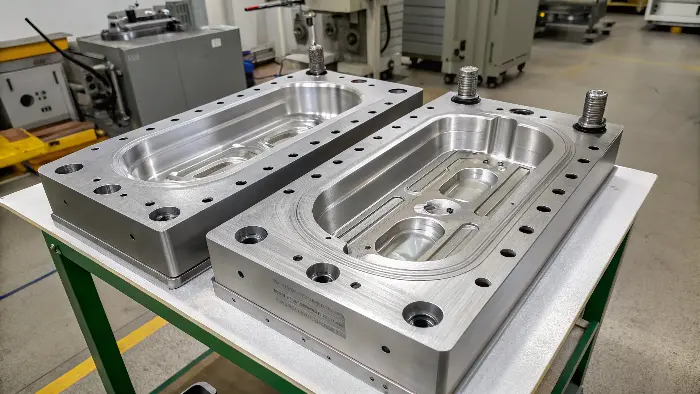Ever wonder how so many plastic items are made? You might be surprised how injection molding quietly shapes your world. Let’s uncover this hidden process.
Injection molding is a key manufacturing method. It creates many plastic items we use daily, from kitchenware to car parts, by injecting molten plastic into molds.
It’s truly fascinating when you start to notice these things. I remember when I first learned about it, my view of everyday objects completely changed. You’re probably surrounded by more injection-molded items than you think. Want to explore further and see how this process impacts almost everything around us?
Can You Find Objects Around Your House Created With Injection Molding?
Look around you right now. Are those plastic items made by hand? Unlikely. Injection molding is probably the secret behind many of them. Let’s find some examples.
Yes, you absolutely can. Many household items like bottle caps, containers, toy parts, and electronic casings are made using injection molding. Just check for small tell-tale marks!
It’s like a little treasure hunt once you know what to look for. I remember when I started in this industry, I began seeing these items everywhere. The pen on your desk? Probably injection molded. The cap on your water bottle? Definitely. Your TV remote casing? Most likely. Even parts of your computer mouse or your kitchen utensils, like a spatula handle or a measuring cup, often come from this process. The reason is simple: injection molding is incredibly efficient for making lots of the same plastic part quickly and cheaply. Think about kids’ building blocks – they need to be identical and strong, and injection molding is perfect for that. It allows for complex shapes too. So, if an item has a smooth, consistent plastic finish and seems mass-produced, there’s a high chance it’s an injection molded product. You might even find a tiny circular mark, called a gate mark, where the plastic was injected, or thin lines where mold halves met.
Identifying Features
You can often spot injection-molded items by looking for specific characteristics:
- Gate Marks: These are small, often circular, blemishes. They show where the molten plastic entered the mold cavity.
- Ejector Pin Marks: You might see small, circular indentations or sometimes slightly raised spots. These are left by the pins that push the finished part out of the mold.
- Parting Lines: These are very fine, faint lines on the surface of the part. They indicate where the two halves of the mold came together.
- Uniformity and Complexity: Mass-produced items with a consistent shape, finish, and often complex geometries are strong candidates.
Learning to spot these features can give you a new appreciation for the manufacturing around you.What Plastic Products Are Commonly Made By Injection Molding?
Curious about the range of items? This process isn’t just for small bits. It creates a huge variety of plastic products we rely on daily. Let’s see.
Injection molding produces a vast array of items. These include automotive parts, electronic housings, medical devices, toys, packaging, bottle caps, and common household goods.

The scope of injection molding is truly impressive. When I was starting my own CNC trading company, I saw firsthand the diversity of molds being made for all sorts of products. It’s not just the small things you might first imagine.Common Categories and Examples:
- Packaging: This is a huge area. Think about food containers, beverage caps, lids for jars, and cosmetic packaging. These items need to be produced in massive volumes, and injection molding is ideal for that. The consistency it offers also ensures a good seal and product integrity, which is vital for packaging.
- Consumer Goods: This category is incredibly broad. Kitchenware like mixing bowls, spatulas, and measuring cups often use injection-molded components. Tool handles, casings for power tools, and parts for garden equipment are common. Then there are toy components, a classic example being LEGO bricks, which require extreme precision to interlock perfectly. Office supplies like pen barrels and stapler bodies are also frequently made this way. I recall a client who specialized in high-volume toy manufacturing; their entire factory was a testament to injection molding’s efficiency and precision.
- Automotive: Many parts inside your car are injection molded. This includes dashboard components, buttons, knobs, interior trim pieces, and even some functional parts under the hood like fluid reservoirs or fan shrouds. The process allows for strong, lightweight parts with complex geometries, which is perfect for automotive applications.
- Electronics: The casing for your smartphone, TV, computer monitor, keyboard, mouse, and other gadgets? Very likely injection molded. It provides the precision needed for fitting all the internal components and circuit boards snugly.
- Medical Devices: Precision and hygiene are paramount here. Items like syringes, sample vials, parts for diagnostic equipment, and various disposable medical tools often use injection molding. It can produce sterile, highly precise components from specialized medical-grade plastics. The repeatability of the process is absolutely critical in this field.
The list truly goes on. The versatility of the process, combined with the wide range of available plastic materials, means that if you see a plastic part that’s made in large quantities, there’s a very strong chance injection molding was the manufacturing method behind it.What Is Plastic Injection Molding Actually Used For?
So we know what it makes, but why this method? Manufacturers choose it for very specific reasons. Let’s explore the core purpose and advantages.
Plastic injection molding is used to mass-produce identical plastic parts with high precision and speed. It’s favored for its efficiency, design flexibility, and cost-effectiveness at scale.

The main reason plastic injection molding is so widely used across so many industries is its incredible efficiency for mass production. I learned this fundamental truth early in my career when I was working at a mold factory. We would see designs come in, and the primary goal was always to manufacture thousands, sometimes millions, of identical parts as quickly and reliably as possible. The process essentially involves heating plastic pellets until they melt into a liquid state. This molten plastic is then injected under high pressure into a precisely machined mold cavity. Once inside, the plastic cools and solidifies, taking the shape of the cavity. Finally, the mold opens, and the finished part is ejected.
Here’s a breakdown of why it’s the go-to method for so many applications:Core Advantages Driving Its Use:
- High Efficiency and Speed (Mass Production): The cycle time – from injecting plastic to ejecting a finished part – can be very short, often just a matter of seconds depending on the part’s size and complexity. This rapid cycling allows for extremely high output rates, making it perfect for mass production. I’ve seen machines churn out parts at an astonishing pace.
- Design Flexibility and Complexity: This is a significant advantage. Injection molding can create parts with very complex and intricate geometries. Think about all the small clips, internal ribs for strength, screw bosses for assembly, and varying wall thicknesses you might find inside an electronics casing or an automotive component. The process handles these features beautifully, offering designers like Jacky a great deal of freedom.
- Wide Material Selection: There’s a vast range of plastic materials, including thermoplastics (which can be re-melted) and thermosets (which undergo a chemical change when heated and cannot be re-melted), that can be used. Each material offers different properties – flexibility, rigidity, impact strength, heat resistance, UV stability, color options, and more. This allows manufacturers to select the perfect material for the product’s specific functional and aesthetic requirements.
- Low Material Waste: Compared to subtractive manufacturing methods like CNC machining (where material is cut away from a larger block), injection molding is very efficient with material. The runners and sprues (excess plastic from the channels that deliver molten plastic to the cavity) can often be reground and mixed with virgin material for reuse, especially with thermoplastics. This minimizes waste, keeps material costs down, and is better for the environment.
- High Repeatability and Consistency: Every part produced from the same mold is virtually identical to the others. This high degree of repeatability ensures that parts meet tight tolerances and maintain consistent quality. This is crucial for products that require precise assembly, like interlocking toy bricks, or for critical applications such as medical devices.
What Is an Example of a Plastic Injection Mold?
The magic happens inside the mold. But what does one look like? It’s more than just a simple cavity. Let’s picture a typical injection mold.
An injection mold is typically a robust, precision-machined two-part steel tool. It has a cavity side and a core side that form the shape of the part when closed.

Imagine a very precise, very strong metal box, often made of hardened steel, that opens and closes with incredible accuracy. That’s a simplified way to think about an injection mold. I’ve handled many molds in my time, from small, simple ones designed to produce a single, tiny component, to large, complex multi-cavity tools that can produce several parts simultaneously with each cycle. The engineering that goes into designing and building these molds is quite sophisticated.
Essentially, even a basic mold has two main halves that come together:Key Components of a Typical Mold:
- The Cavity (often called the "A" side or fixed half): This is usually the stationary half of the mold that attaches to the fixed platen of the injection molding machine. It often forms the exterior, cosmetic, or "show" surface of the plastic part. The cavity is meticulously machined and polished to create the desired shape and surface finish.
- The Core (often called the "B" side or moving half): This is typically the moving half of the mold, attached to the moving platen of the machine. It forms the internal features or the non-cosmetic side of the part. When the mold closes, the core fits precisely into the cavity, leaving a defined space between them – this space is where the molten plastic flows and solidifies to form the part.
Beyond these two main forming parts, a mold also includes several other critical systems: - Sprue Bushing: This is the entry point for the molten plastic. The nozzle of the injection molding machine’s barrel presses against the sprue bushing to inject the plastic into the mold.
- Runner System: These are channels machined into the face of one or both mold halves. They guide the molten plastic from the sprue bushing to the gate(s) of the cavity (or cavities, in a multi-cavity mold).
- Gate(s): The specific, constricted entry point(s) where the molten plastic actually enters the part cavity. The type, size, and location of the gate are critical design elements that affect part quality, fill characteristics, and cosmetic appearance.
- Ejector System: This system is located on the core side. It consists of pins, sleeves, or plates that push the cooled, solidified plastic part out of the mold once it opens after the cooling phase. You can often see small, circular marks (ejector pin marks) on finished parts where these pins made contact.
- Cooling Channels (or Heating Channels): These are passages drilled within the mold halves through which a fluid (usually water or oil) circulates. This system controls the temperature of the mold, ensuring the plastic cools and solidifies at the optimal rate for part quality and cycle time.
For example, a mold for a simple plastic cup would have a cavity shaping the outside walls and base, and a core shaping the inside volume. It’s a real feat of precision engineering, designed for durability and high-volume production!Conclusion
Injection molding creates countless everyday plastic items efficiently and precisely. It’s a vital process shaping our modern world, from homes to industries, thanks to its versatility.
